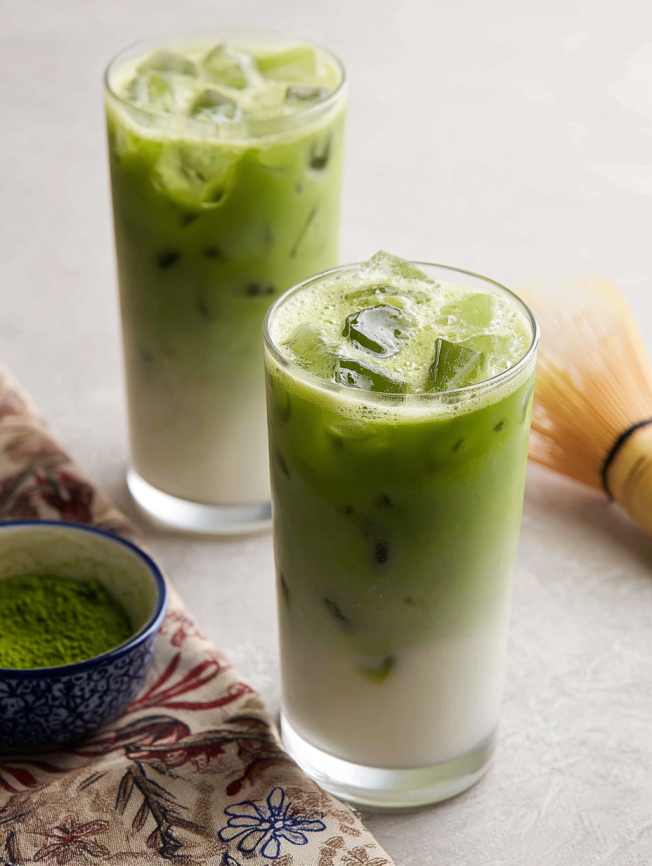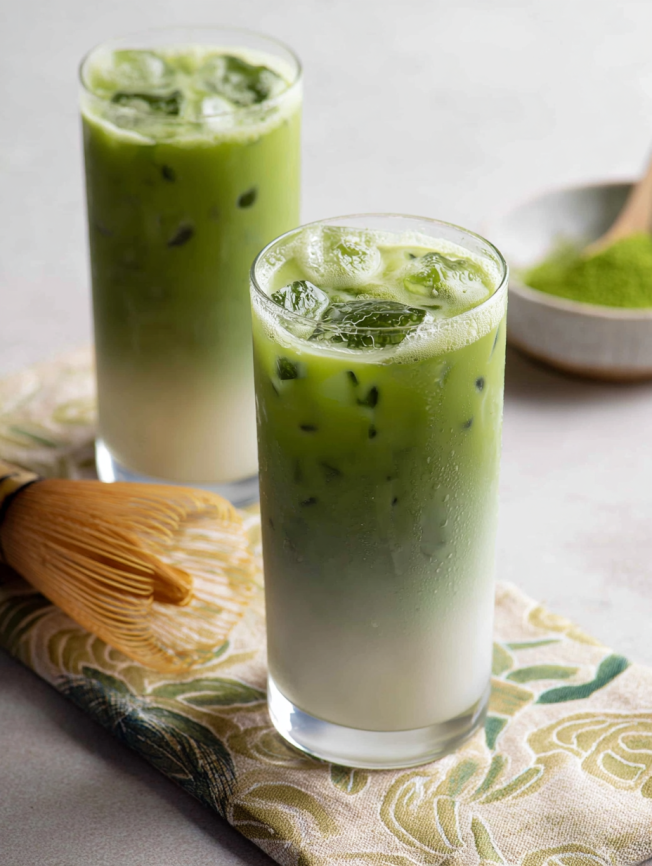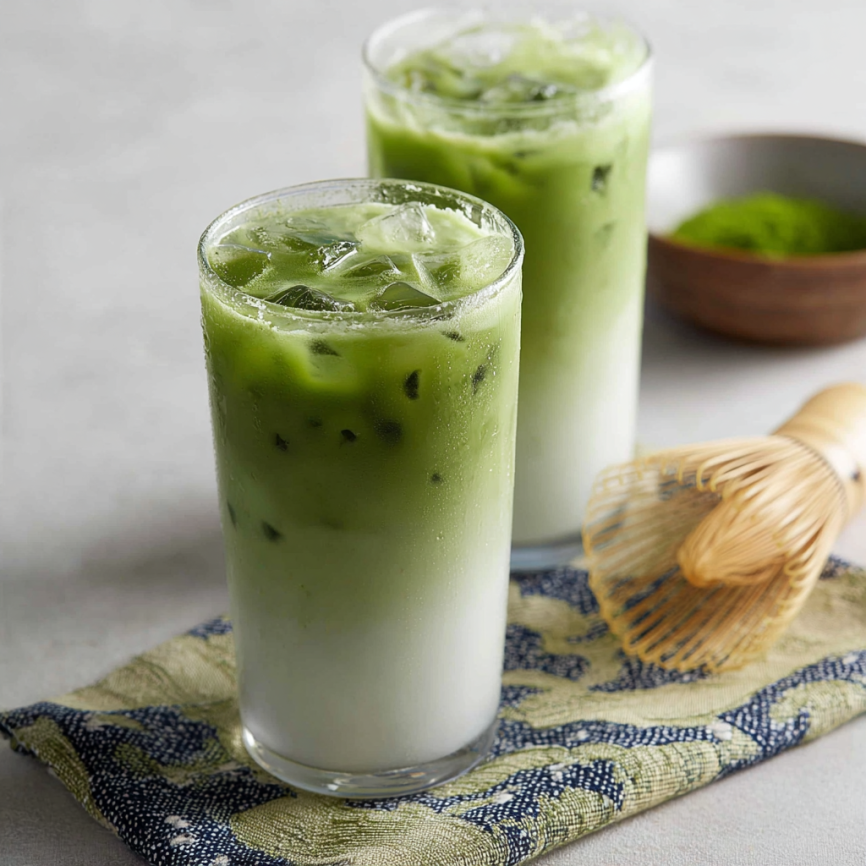My obsession with matcha lattes began during a sweltering summer morning in Kyoto, where a tiny café served the most perfectly balanced iced matcha latte I’d ever tasted. The vibrant green color, velvety texture, and that distinctive earthy-sweet flavor combination created an instant addiction that followed me home. After countless experiments with different matcha grades, whisking techniques, and milk combinations, I’ve finally mastered the art of creating café-quality iced matcha lattes that rival those found in Japan’s best tea houses.
Why This Iced Matcha Latte Will Transform Your Morning Routine
Pure, Clean Energy Without the Crash
Unlike coffee’s sharp caffeine hit, matcha provides sustained energy through L-theanine, an amino acid that promotes calm alertness. Furthermore, this natural combination prevents the jittery feeling and afternoon crash associated with traditional coffee drinks.
Antioxidant Powerhouse
Matcha contains significantly more antioxidants than regular green tea, providing powerful health benefits in every sip. Additionally, the ceremonial-grade preparation method preserves these beneficial compounds while creating an incredibly satisfying beverage experience.
Customizable Creaminess
This recipe works beautifully with any milk preference, from rich whole dairy to creamy oat milk. Moreover, the base technique remains consistent regardless of your chosen milk, making it perfect for households with varying dietary needs.
Instagram-Worthy Presentation
The vibrant green color and beautiful layered appearance make this latte as visually appealing as it is delicious. Consequently, every glass becomes a small celebration that brightens both your kitchen and social media feed.
Essential Ingredients for Matcha Latte Perfection
The Foundation
- 1 teaspoon matcha powder – Choose ceremonial or café-grade for best flavor and color
- 3 tablespoons hot water – Heated to exactly 180°F for optimal extraction
- 3 tablespoons cold water – Helps balance temperature and creates proper consistency
Creamy Components
- ¾ cup milk of choice – Whole milk, oat milk, almond milk, or any preferred variety
- Optional sweeteners – Simple syrup, maple syrup, honey, or granulated sugar
Quality Matters
Invest in high-quality matcha powder, as it dramatically affects both flavor and color. Additionally, sifting the matcha before mixing eliminates clumps that can ruin the smooth texture essential to a perfect latte.
Step-by-Step Instructions for Matcha Mastery
Preparation Phase
Begin by sifting your matcha powder through a fine mesh strainer into a small bowl. This crucial step removes any clumps that could create an unpleasant grainy texture in your finished latte.
Creating the Matcha Base
Heat water to 180°F – steaming but not boiling – and add it to your sifted matcha powder. Using a bamboo whisk or small wire whisk, create vigorous zigzag motions to fully incorporate the powder without leaving any lumps behind.
Temperature Balancing
Add the cold water to your whisked matcha mixture, continuing to whisk until completely combined. This step creates the perfect temperature for serving while maintaining the matcha’s vibrant color and smooth consistency.
Assembly Process
Fill your serving glass two-thirds full with ice cubes, ensuring you leave room for both milk and the matcha mixture. Pour in your chosen milk, creating a creamy base layer.
Final Integration
Slowly pour the prepared matcha mixture over the milk, creating beautiful color gradients. Stir gently to combine, or leave layered for an impressive visual presentation that photographs beautifully.

Milk Options and Flavor Profiles
Dairy Variations
Whole milk creates the richest, creamiest texture, while skim milk provides a lighter option that still maintains good mouthfeel. Heavy cream can be added for extra indulgence, though it may overpower the delicate matcha flavor.
Plant-Based Alternatives
Oat milk provides exceptional creaminess and subtle sweetness that complements matcha perfectly. Alternatively, almond milk offers a lighter option, while coconut milk adds tropical richness and natural sweetness.
Flavor Considerations
Each milk variety interacts differently with matcha’s earthy notes. Consequently, experimenting with different options helps you discover your preferred balance between creaminess and flavor intensity.
Sweetening Options and Techniques
Traditional Sweeteners
Simple syrup integrates most smoothly into cold beverages, while honey adds floral complexity that pairs beautifully with matcha’s earthiness. Maple syrup provides warmth and depth, creating a more complex flavor profile.
Integration Methods
Add sweeteners during the whisking phase for best incorporation, or stir them directly into the finished latte. Granulated sugar should be whisked with the hot water and matcha to ensure complete dissolution.
Sweetness Balance
Start with minimal sweetener and adjust to taste, as high-quality matcha has natural sweetness that may not require additional enhancement. Remember that different milk varieties contribute varying levels of natural sweetness.
Hot Matcha Latte Variation
Temperature Adjustment
For hot versions, use only hot water (no cold water addition) and heat your milk to steaming. Maintain the same whisking technique to achieve proper matcha integration and foam development.
Serving Considerations
Hot matcha lattes should be served immediately in pre-warmed mugs to maintain optimal temperature. The flavor profile differs slightly from iced versions, with more pronounced earthy notes and enhanced aromatics.
Make-Ahead Tips for Busy Mornings
Matcha Concentrate
Prepare larger batches of whisked matcha concentrate and store refrigerated for up to 24 hours. This approach significantly reduces morning preparation time while maintaining quality and flavor.
Batch Preparation
Sift several days’ worth of matcha powder and store in an airtight container. Pre-measuring portions into small containers streamlines the weekday routine without compromising freshness.
Professional Techniques and Tips
Whisking Mastery
Create vigorous M-shaped or zigzag motions rather than circular stirring for best results. The goal is incorporating air while breaking apart any stubborn clumps that survived the sifting process.
Temperature Precision
Use a thermometer initially to understand what 180°F water looks like and feels like. Over time, you’ll develop the ability to judge proper temperature by sight and steam patterns.
Storage Considerations
Store matcha powder in the refrigerator or freezer to maintain vibrant color and fresh flavor. Additionally, use opened matcha within 6-12 months for best quality and potency.
Essential Notes for Success
Quality Investment
High-quality matcha makes an enormous difference in both flavor and appearance. Ceremonial grade provides the best experience, while culinary grade works acceptably for daily drinking but may require additional sweetener.
Sifting Importance
Never skip the sifting step, as clumped matcha creates an unpleasant drinking experience that’s difficult to correct after liquid addition. This small effort dramatically improves the final result’s smoothness and appearance.
Serving Timing
Matcha lattes are best enjoyed immediately after preparation, as the powder can settle over time. If needed, a quick stir will redistribute settled particles and restore proper consistency.

Frequently Asked Questions
Why is my matcha latte bitter?
Bitter matcha usually results from water that’s too hot (over 180°F) or low-quality powder. Additionally, some matcha varieties are naturally more astringent and may require sweetener to balance the earthiness.
Can I use regular green tea powder instead of matcha?
Regular green tea powder won’t provide the same flavor, color, or texture as true matcha. Matcha’s unique processing method creates its distinctive characteristics, making substitution inadvisable for authentic results.
How do I prevent clumpy matcha?
Always sift matcha powder before adding liquid, and whisk vigorously in zigzag patterns rather than circular motions. Furthermore, using the proper water temperature helps the powder dissolve more completely.
What’s the difference between ceremonial and culinary grade matcha?
Ceremonial grade matcha offers superior flavor, color, and smoothness, making it ideal for lattes and traditional tea preparation. Culinary grade works for cooking and budget-conscious daily drinking but may require more sweetener.
Can I make this dairy-free?
Absolutely! Plant-based milks work excellently in matcha lattes. Oat milk provides the closest texture to dairy milk, while almond, soy, and coconut milks each offer unique flavor profiles that complement matcha beautifully.
How long does prepared matcha last?
Fresh matcha lattes should be consumed immediately for best flavor and appearance. However, whisked matcha concentrate can be refrigerated for up to 24 hours, though the color may slightly fade over time.
Why is my matcha pale green instead of vibrant?
Pale color typically indicates lower-quality matcha powder or improper storage. High-quality, properly stored matcha should produce a vibrant jade green color that’s visually striking and Instagram-worthy.
Nutritional Information (per serving): 122 calories, 9g carbohydrates, 8g protein, 6g fat, 74mg sodium, 275mg potassium, 9g sugar

